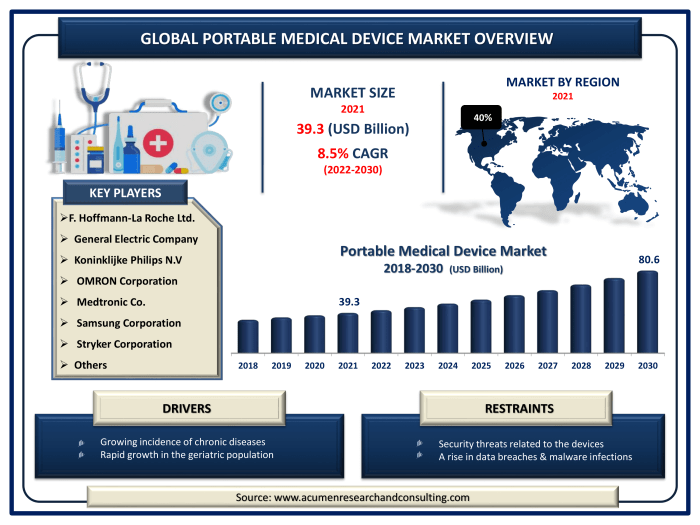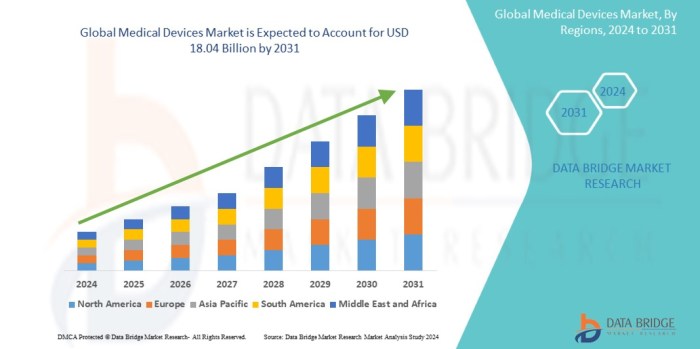
The medical device market is a dynamic and rapidly evolving landscape, shaped by technological breakthroughs, demographic shifts, and evolving healthcare needs. This analysis delves into the key drivers of market growth, examining factors such as the increasing prevalence of chronic diseases, an aging global population, and the continuous innovation in medical technology. We will explore the competitive dynamics, regulatory frameworks, and the significant impact of emerging technologies like AI and 3D printing on this crucial sector.
From analyzing market size and segmentation to understanding the competitive strategies of major players and navigating the complexities of regulatory approvals, this comprehensive overview provides a detailed picture of the current state and future trajectory of the medical device market. We will also explore the intricate relationships between medical device development, medical research, and the delivery of healthcare services.
Market Segmentation by Product Type

The medical device market is incredibly diverse, encompassing a wide array of products designed for various medical applications. Understanding the segmentation by product type is crucial for effective market analysis, allowing for a targeted approach to investment, development, and strategic planning. This section will delve into several key segments, providing an overview of their market size, growth trajectories, and prominent trends.
The following table provides a high-level summary of key medical device segments. Note that market sizes and growth rates are estimates based on publicly available data and may vary depending on the source and year.
| Segment | Market Size (USD Billion, Estimated 2023) | Growth Rate (CAGR, 2023-2028, Estimated) | Key Trends & Innovative Products |
|---|---|---|---|
| Cardiovascular Devices | 150-170 | 5-7% |
|
| Orthopedic Devices | 120-140 | 4-6% |
|
| Diagnostic Imaging | 100-120 | 6-8% |
|
| Neurological Devices | 60-80 | 7-9% |
|
Cardiovascular Device Market Dynamics
The cardiovascular device market is a significant segment, driven by the increasing prevalence of cardiovascular diseases globally. Technological advancements are leading to improved treatment outcomes and patient experiences. The market is characterized by intense competition among established players and emerging companies, with a focus on innovation and product differentiation.
Orthopedic Device Market Dynamics
The orthopedic device market is another substantial segment, fueled by the aging population and rising incidence of orthopedic injuries and conditions. The trend towards minimally invasive procedures and personalized medicine is reshaping this market. The demand for high-quality, durable, and biocompatible implants is steadily increasing.
Diagnostic Imaging Market Dynamics
The diagnostic imaging market is experiencing rapid growth due to the increasing adoption of advanced imaging technologies and the growing demand for early and accurate disease diagnosis. The integration of artificial intelligence is revolutionizing the field, enhancing diagnostic accuracy and efficiency while reducing the workload on radiologists.
Neurological Device Market Dynamics
The neurological device market is witnessing significant growth, driven by the increasing prevalence of neurological disorders and advancements in neurostimulation therapies and brain-computer interfaces. The development of less invasive surgical techniques and improved patient outcomes are key drivers of market expansion. This segment is characterized by high regulatory hurdles and a strong focus on clinical evidence.
Relationship between MEDICAL DEVICES, MEDICAL RESEARCH, and MEDICAL SERVICES

The medical landscape is a complex ecosystem where medical devices, medical research, and medical services are inextricably linked. Advancements in one area invariably impact the others, creating a dynamic interplay that continually shapes healthcare delivery and patient outcomes. Understanding this interconnectedness is crucial for optimizing healthcare systems and fostering innovation.Medical research, medical devices, and medical services are interdependent components of a larger healthcare system.
Each element influences and is influenced by the others, creating a continuous cycle of innovation and improvement.
Medical Research Driving Innovation in Medical Devices and Improving Medical Services
Medical research is the fundamental driver of progress in both medical devices and the quality of medical services. New discoveries in biology, chemistry, and engineering directly translate into the development of novel medical devices and refined treatment protocols.The relationship between medical research, device innovation, and improved services can be illustrated as follows:
- Improved Diagnostics: Research into biomarkers and imaging techniques leads to the development of more sensitive and specific diagnostic devices (e.g., advanced MRI machines, rapid diagnostic tests), enabling earlier and more accurate disease detection, thus improving treatment outcomes and potentially reducing healthcare costs associated with delayed diagnoses.
- Targeted Therapies: Research into disease mechanisms and drug delivery systems fuels the creation of sophisticated medical devices for targeted drug administration (e.g., drug-eluting stents, implantable insulin pumps), leading to more effective treatments with fewer side effects and improved patient quality of life.
- Minimally Invasive Procedures: Research in robotics and materials science has resulted in the development of minimally invasive surgical instruments (e.g., laparoscopic tools, robotic surgery systems), improving patient recovery times, reducing hospital stays, and lowering the risk of complications. This directly improves the efficiency and effectiveness of medical services.
- Personalized Medicine: Research into genomics and proteomics is paving the way for personalized medicine, where medical devices are tailored to individual patient needs (e.g., 3D-printed implants, customized prosthetics). This approach enhances treatment effectiveness and patient satisfaction, significantly impacting the quality of medical services.
The Role of Medical Devices in Facilitating Medical Research and Improving the Quality of Medical Services
Medical devices play a crucial role in both advancing medical research and enhancing the quality of medical services. They act as essential tools, enabling researchers to conduct experiments and clinicians to provide better patient care.The following table summarizes this role:
| Area | How Medical Devices Facilitate Research | How Medical Devices Improve Medical Services | Examples |
|---|---|---|---|
| Diagnostics | Improved imaging and analytical tools allow for more precise and efficient data collection during research studies. | Faster and more accurate diagnosis enables timely interventions and treatment plans. | Advanced MRI machines, blood glucose monitors, genetic sequencing devices |
| Treatment | Devices provide controlled environments for drug testing and experimental therapies, leading to faster development of new treatments. | Improved treatment efficacy and reduced side effects, enhancing patient outcomes and satisfaction. | Implantable drug delivery systems, pacemakers, neurostimulators |
| Surgery | Minimally invasive surgical tools allow for complex research procedures with reduced risk and faster recovery. | Less invasive procedures lead to faster recovery times, reduced pain, and lower risk of complications. | Robotic surgery systems, laparoscopic instruments, advanced surgical lasers |
| Monitoring | Continuous monitoring devices provide real-time data on physiological parameters, essential for research on disease progression and treatment efficacy. | Improved patient safety and proactive management of health conditions, leading to better overall care. | Wearable health trackers, implantable cardiac monitors, continuous glucose monitors |
In conclusion, the medical device market presents a complex interplay of technological advancement, regulatory hurdles, and intense competition. Understanding the market dynamics, including segmentation, key players, and regulatory landscapes, is crucial for stakeholders across the industry. The future trajectory of this market is undeniably bright, driven by ongoing technological innovation and the persistent need for improved healthcare solutions.
This analysis serves as a valuable resource for navigating this dynamic and vital sector.
Popular Questions
What are the biggest challenges facing the medical device industry?
Significant challenges include stringent regulatory pathways, high research and development costs, intense competition, and the need to balance innovation with cost-effectiveness.
How is the medical device market impacted by global economic conditions?
Economic downturns can affect healthcare spending, impacting demand for medical devices. Conversely, economic growth can stimulate investment and innovation within the sector.
What is the role of intellectual property in the medical device market?
Intellectual property, including patents and trademarks, is crucial for protecting innovations and securing market share. It drives competition and incentivizes investment in R&D.
How does sustainability impact the medical device industry?
Growing concerns about environmental impact are pushing the industry towards sustainable manufacturing practices, using recycled materials, and reducing waste.

